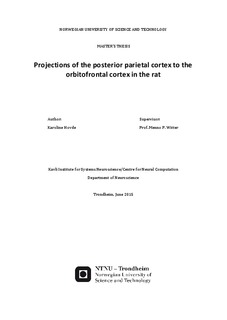| dc.description.abstract | The posterior parietal cortex (PPC) in the rat is a multimodal association area, implicated in spatial processing, decision-making, working memory and directed attention. PPC is commonly divided into a medial (mPPC), a lateral (lPPC) and a posterior (PtP) region, all reciprocally connected to specific parts of the thalamus. The orbitofrontal cortex (OFC) is part of the ventral prefrontal cortex and is commonly divided into the medial orbital (MO), ventral orbital (VO), ventrolateral orbital (VLO), lateral orbital (LO) and dorsolateral orbital (DLO) cortices. The subregions of OFC have distinct connectivity patterns and are functionally different regarding spatial information processing, value-based decision-making and behavioural flexibility.
Reciprocal connections between PPC and OFC have previously been described, but variations in delineation of both cortical regions and difficulties in distinguishing PPC from the secondary visual cortex (V2) hampered a clear understanding of the connections. Moreover, no study has addressed PPC-OFC projections, differentiating the origins in the three posterior parietal subdivisions.
The aim of this study was therefore to describe the projections of PPC to the subregions of OFC, with a special focus on the differences in projection patterns arising from the three subregions of PPC. To this end, we injected the anterograde tracers 10 KD biotinylated dextran amine (BDA) and phaseolus vulgaris-leucoagglutinin (PHA-L) into the subregions of PPC. The retrograde tracers Fast Blue (FB) and Fluorogold (FG) were injected into VO and VLO to study the layers of origin of these projections. The brains were cut in the coronal plane and cortical areas were delineated based on Nissl stains with Cresyl Violet. Anterograde tracers were visualised using either 3.3’-diaminobenzidin tetrahydrochloride (DAB) or AlexaFluor® dyes, and their distribution, as well as that of the retrograde fluorescent tracers was analysed with conventional microscopical techniques.
Anterograde tracing showed that the projections from PPC to OFC are not strong, which is supported by the retrograde tracer cases that showed an overall low number of labelled neurons in layers V and VI of PPC. mPPC projects mainly to lateral VO and medial VLO, with some sparse projections to MO. Projections from lPPC terminate in medial VLO, while the most lateral part of PPC, PtP, projects to central to lateral VLO. The results indicate that projections from PPC target OFC, showing a subtle topographical pattern within MO, VO and VLO, with a clear preference for VO and VLO and excluding LO and DLO. | nb_NO |
